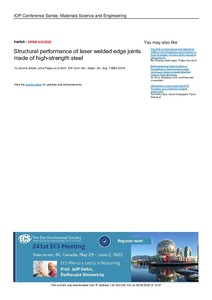Structural performance of laser welded edge joints made of high-strength steel
Peippo Juha; Salminen Antti; Björk Timo; Ahola Antti
https://urn.fi/URN:NBN:fi-fe2022081154419
Tiivistelmä
Laser welding is a widely-used fusion welding process in industry. However, laser welding is not a common welding process in the manufacture of industrial crane structures. There has been a remarkable increase in the available strength classes of steel grades over the last 10 years, such that strengths of up to 1200 MPa are now commercially available. This enables the use of thinner materials in welded products and at the same time, has opened up new possibilities for using laser welding more widely in the manufacture of steel structures. This study focuses on the static and fatigue strength of the laser-welded joints. Details investigated are edge joint with flange preparation between two rectangular tubes and edge joint between flat bar and rectangular tube. A novel fatigue strength assessment concept, the FAT(mod) method, is applied to assess the theoretical fatigue performance of the joint in comparison with the effective notch stress method with a FAT630 design curve. The FATmod method is based on the local stress ratio at a fatigue-critical point of the joint and the analysis considers the strength of the material, surface quality and applied stress ratio in the assessment of fatigue. The study shows that the samples failed from the base material side in static tests and the FAT(mod) method developed was found to agree well with the test results.
Kokoelmat
- Rinnakkaistallenteet [19207]
